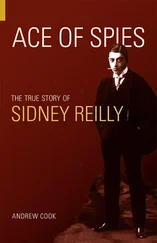Gordon Thomas - Gideon's Spies
Здесь есть возможность читать онлайн «Gordon Thomas - Gideon's Spies» весь текст электронной книги совершенно бесплатно (целиком полную версию без сокращений). В некоторых случаях можно слушать аудио, скачать через торрент в формате fb2 и присутствует краткое содержание. Город: New York, Год выпуска: 2009, ISBN: 2009, Издательство: Thomas Dunne Books, Жанр: История, на английском языке. Описание произведения, (предисловие) а так же отзывы посетителей доступны на портале библиотеки ЛибКат.
- Название:Gideon's Spies
- Автор:
- Издательство:Thomas Dunne Books
- Жанр:
- Год:2009
- Город:New York
- ISBN:978-0-312-53901-6
- Рейтинг книги:4 / 5. Голосов: 1
-
Избранное:Добавить в избранное
- Отзывы:
-
Ваша оценка:
- 80
- 1
- 2
- 3
- 4
- 5
Gideon's Spies: краткое содержание, описание и аннотация
Предлагаем к чтению аннотацию, описание, краткое содержание или предисловие (зависит от того, что написал сам автор книги «Gideon's Spies»). Если вы не нашли необходимую информацию о книге — напишите в комментариях, мы постараемся отыскать её.
Gideon’s Spies
Gideon's Spies — читать онлайн бесплатно полную книгу (весь текст) целиком
Ниже представлен текст книги, разбитый по страницам. Система сохранения места последней прочитанной страницы, позволяет с удобством читать онлайн бесплатно книгу «Gideon's Spies», без необходимости каждый раз заново искать на чём Вы остановились. Поставьте закладку, и сможете в любой момент перейти на страницу, на которой закончили чтение.
Интервал:
Закладка:
A senior Israeli intelligence officer undoubtedly spoke for many when he said:
“While we all agreed there could be no objection to the principle that to cut off the head kills the snake, it was the time frame which was our concern. All Bibi’s talk about ‘action now’ was pure bullshit. Any operation of that nature requires careful planning. Bibi wanted results as if this was a computer game, or one of those old action-hero movies he likes to watch. But it just doesn’t work like that in the real world.”
Yatom ordered a full search of every Arab country and sent katsas into Gaza and the West Bank to discover more about the whereabouts of the shadowy figures who control Hamas. Throughout August 1997, he was summoned several times to the prime minister’s office to report on his progress. There was none. The Israeli intelligence community was rife with accounts of how the prime minister had demanded that Yatom put more men into the field and had begun to hint that if he didn’t see results soon, he might have to take “other actions.” If Netanyahu had intended this to be a clumsy threat to his Mossad chief, it did not work. Yatom simply said he was “doing everything possible.” The unspoken implication was that if the prime minister wanted to fire him, that was his prerogative; but in the public debate that would inevitably follow, there would be questions asked about Netanyahu’s own role. But the prime minister continued to press for the death of a Hamas leader—and he wanted it sooner rather than later.
By September 1997, Netanyahu had begun to call Yatom at all hours of the night about progress. The pressurized Mossad chief bowed. He pulled in katsas from other stations. For one, “Yatom was rearranging the map as a knee-jerk to Bibi’s demands. Yatom is one tough guy. But when it came to push-and-shove, he was just no match for Bibi, who had started to talk about how quickly his brother had helped to put together the raid on Entebbe. The comparison had no meaning. But that’s Bibi all over—use anything that can push his case.”
On September 9, news reached Tel Aviv that Hamas had struck again, this time seriously wounding two Israeli bodyguards of the cultural attaché at the newly opened Israeli embassy in Amman, the Jordanian capital.
Three days later, shortly before the Friday Sabbath began, Netanyahu requested that Yatom join him for lunch at his home in Jerusalem. The two men sat down to a meal of soup, salad, and a fish course, washed down with beer and bottled water. The prime minister immediately raised the attack in Amman. How could the Hamas gunmen have come close enough to shoot? Why had there been no advance warning? What was the Mossad station in Amman doing about it?
Yatom interrupted Netanyahu in midflow: There was a Hamas leader in Amman named Khalid Meshal who ran the organization’s politburo from an office in the city. For weeks Meshal had been traveling through various Arab countries, but Amman station reported that he was back in the city.
Netanyahu was galvanized. “Then go and knock him down!” he said across the table. “That’s what you have to do. Knock him down! Send your people in Amman to do that!”
Stung by almost six weeks of relentless pressure from a prime minister who increasingly had appeared to have no grasp of the political sensitivity of any intelligence operation, the Mossad chief delivered a sharp lesson. Eyes glinting behind his spectacles, he warned that to launch an attack in Amman would destroy the relationship with Jordan that Netanyahu’s predecessor, Yitzhak Rabin, had created. To actually kill Meshal on Jordanian soil would jeopardize Mossad’s operations in a country that had yielded a continuous flow of intelligence about Syria, Iraq, and Palestinian extremists. Yatom suggested it would be better to wait until Meshal once more left Amman and then strike.
“Excuses! That’s all you give me! Excuses!” Netanyahu was said to have shouted. “I want action. I want it now. The people want action. It’s Rosh Hashanah soon!” he added, in a reference to the Jewish New Year. “This will be my gift to them!”
From that moment on, every move that Yatom made would be personally approved by Netanyahu. No other Israeli prime minister had taken such a close personal interest in a state-sponsored act of murder.
Khalid Meshal was forty-one years old, a full-bearded and physically strong man. He lived close to King Hussein’s palace and by all accounts was a devoted husband and father of seven children. Cultured and well-spoken, he had remained a little-known figure in the Islamic fundamentalist movement. But the rapidly assembled data that Mossad’s Amman station had put together indicated Meshal was the driving force behind the suicide bomb attacks against Israeli civilians.
Details of Meshal’s movements had been furnished, together with a photograph the Mossad head of station had surreptitiously taken. With his report was a personal plea that Yatom should once more try to persuade Netanyahu not to go ahead with an assassination in Amman. Such a reckless action would jeopardize two years of important counterespionage work Mossad had done with Jordan’s cooperation.
Netanyahu had rejected the plea, saying it sounded like a prediction of failure, something he would not tolerate.
Meantime, an eight-man kidon squad had been preparing: a two-man team would actually carry out the hit in broad daylight; the others would provide backup, including car support. The team would all drive back into Israel, crossing over at the Allenby Bridge near Jerusalem.
Mossad’s weapon of choice was unusual, not a gun, but an aerosol filled with a nerve agent. It would be the first time a kidon hit team had used this method of killing, though it had long been perfected by the KGB and other Soviet Bloc intelligence agencies. Russian scientists recently emigrated to Israel had been recruited by Mossad to create a range of deadly toxins, including tabun, sarin, and soman, nerve agents that were all outlawed under international treaties. The substances were intended to produce death that could be instantaneous or lingering; in all cases the victim lost control over his internal organs and suffered pain so excruciating that death itself would be a merciful release. This form of killing had been selected as appropriate for Meshal.
On September 24, 1997, the kidon unit flew into Amman from Athens, Rome, and Paris, where they had been positioned for several days. Some members traveled on French and Italian documents. The hit men had been given Canadian passports in the names of Barry Beads and Sean Kendall. They told staff when they checked into the city’s Intercontinental Hotel they were tourists. The other katsas bedded down in the Israeli embassy a short distance away.
Beads and Kendall joined them the next day. The two men once more inspected the aerosol. No one knew which nerve agent it contained. The agents speculated that it could induce anything from hallucinations to heart failure before death. They were briefed on the latest movements of Meshal by the station chief.
He had been in London in September 1978 when a Bulgarian defector, Georgi Markov, had been killed by a nerve agent. A passerby had jabbed him in the thigh with the tip of an umbrella. Markov had died an excruciating death caused by ricin, a deadly poison made from the seeds of the castor-oil plant. The passerby had been a KGB agent who had never been caught.
On that optimistic note, Beads and Kendall returned to their hotel shortly before midnight. Each ordered a room service breakfast of coffee, orange juice, and Danish pastries. Next morning, at 9:00 A.M., Beads appeared in the lobby and signed for the first of two rented cars, a blue Toyota. The second, a green Hyundai, arrived shortly afterward and was claimed by Kendall. He told one of the front-desk staff that he and “his friend” were going to explore the south of the country.
Читать дальшеИнтервал:
Закладка:
Похожие книги на «Gideon's Spies»
Представляем Вашему вниманию похожие книги на «Gideon's Spies» списком для выбора. Мы отобрали схожую по названию и смыслу литературу в надежде предоставить читателям больше вариантов отыскать новые, интересные, ещё непрочитанные произведения.
Обсуждение, отзывы о книге «Gideon's Spies» и просто собственные мнения читателей. Оставьте ваши комментарии, напишите, что Вы думаете о произведении, его смысле или главных героях. Укажите что конкретно понравилось, а что нет, и почему Вы так считаете.












